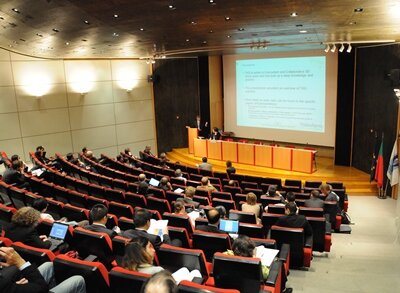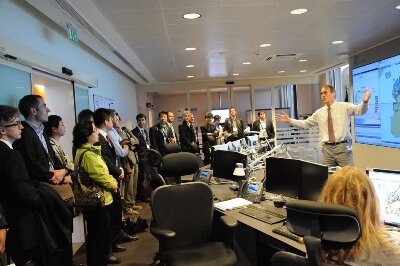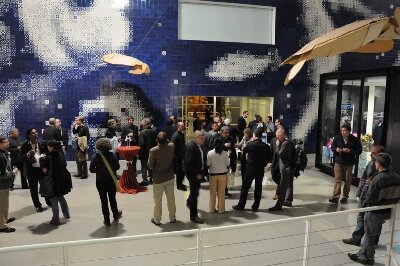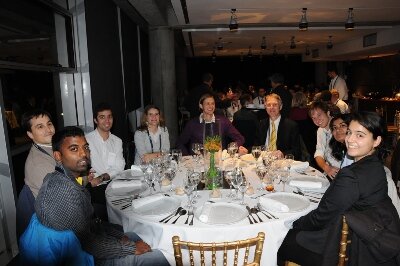SECESA 2012 - Lisbon
The city of Lisbon was the venue for the fifth International Workshop on Systems and Concurrent Engineering for Space Applications (SECESA 2012) jointly organised by ESA and the Instituto Superior Tecnico (IST) at the Almeda campus. Once again, the workshop proved to be an excellent forum for systems engineers and specialists working in a concurrent engineering environment to discuss common problems, show each other new software, applications, tools and methodologies and to share the direction being taken by others in the space engineering community.
With over 60 papers and keynote speeches and 14 posters in the poster session, the workshop was spread over 3 days and comprised 10 distinct sessions:
• CE Facilities: Technical Challenges, Knowledge Management, Educational Perspectives
• SE&CE Processes and Methodologies for Space Applications from Small Satellites to Complex Systems
• SE&CE Tools and Models – General SE Tools
• SE&CE Tools and Models – Domain Specific Tools
• European Indusrial Primes SE Trends
• New SE&CE Processes and Methodologies for Space Applications
• Product Data Exchange
• New SE&CE Processes and Methodologies for Non Space Applications
• Interoperability and Distributed Concurrent Design Centres
• MBSE : Fundamentals and Applications
The posters were a mixture of static presentations and interactive demonstrations and were located in the central atrium area, so were accessible to all the delegates at every coffee break as well as the dedicated poster sessions.

Session 1 on Technical Challenges, Knowledge Management, Educational Perspectives was a mixture of Industry and Academia presentations ranging from the CDF at EPFL in Switzerland to the potential of knowledge based engineering for space application design from Birmingham City University (UK). The session ended with a humerous and highly informative presentation from Robin Biesbroek (ESA) on the findings of a CDF team leader.
Following the first session, there was a very inspiring key note speech from Professor Heinz Stoewer entitled Model Based Engineering and Model Based System Engineering – are we approaching the golden age of simulation?
Session 2, SE & CE Processes and Methodologies for Space Applications: From Small Satellites to Complex Systems was a more traditional session, with excellent papers giving examples of on-going studies including a talk from JAXA on technology demonstration mission SDS-4 and its lessons learned. C. Morlet (ESA) gave an interesting talk on the progress of the IRIS programme, defining the satellite communication system behind the future air traffic management system.

Session 3, SE&CE Tools and models – General SE tools, covered presentations ranging from automated sensitivity analysis from DLR (D) to a description of the Increment Tools (a tool to enhance concurrent design activities) from the IST (P).
Session 4 was also about SE&CE tools but this time domain specific tools and included two presentations, a generic tool for space instrument design called SIM2 and a tool using Dynamis simulation to apply MBSE to component development in small satellite design. Unfortunately a presentation on a dynamic simulator for the assessment of the electrical power subsystem had to be withdrawn due to the lack of a presenter. However, this allowed more time for the poster session.
Due to the large number of papers submitted, sessions 2, 3 and 4 were held in parallel in two adjoining rooms, with people swapping between rooms to hear the presentations they were interested in.

Session 5 brought all the delegates back together in the main auditorium and covered European industrial primes SE trends and practices. It included presentations from EADS Astrium (D), OHB System (D), Thales Alenia Space (I). All the presentations included a question and answer session and people were very interested to hear the opinions of these prime players in the European satellite industry.
Day 1 concluded with a welcome drink and a variety of local delicacies to all participants.
Sessions 6 focussed on New SE&CE processes and methodologies for space applications and included a number of very interesting presentations on subjects as diverse as responsive space methodologies and tools (L. Simonini TAS-F), the ESA virtual spacecraft design, to the applicability of concurrent space engineering in phase B from DLR (D).

Session 7 was quite novel as it was on product data exchange, which up until this year had utilised its own workshop to discuss the subject. It was felt that there were certain synergies with the systems and concurrent engineering approach and this year it was decided to merge the product data exchange into the SE&CE workshop. This appeared to work very well with the session well attended and speakers from many different organisations and universities exchanging ideas and methodologies.
After the lunch break, there was a key note speech from B. Sherwood NASA JPL (USA) on concurrent Innovation of space mission concepts: JPL’s New Model. The talk illustrated how the JPL Innovation Foundry now integrates all mission formulation activities at the laboratory up to the beginning of Phase B.
Session 8 was devoted to SE&CE processes for non-space applications and included a presentation from TAP maintenance and Engineering (P) on their use of mobile Radio Frequency Identification (RFID) associated with the aeronautical industry. There was also a talk from the European Maritime Safety Agency (EMSA) on the tool used by the agency for providing improved maritime domain awareness.
Session 9 covered interoperability and distributed concurrent design centres and included presentations from NASA, TAS (I & F), CNES and the Chinese academy of Sciences, so people were able to get a worldwide impression of how people are dealing with the problems associated with distributed concurrent engineering.

On Thursday afternoon, SECESA participants had the opportunity to visit the European Maritime Safety Agency (EMSA). Situated in the heart of Lisbon, this organisation works 24/7 to provide fast and accurate information on ship movement in Europe and beyond. The complexity of the task carried out by EMSA and the amount of data handled by them is impressive and their use of integrated monitoring systems including land and sea based as well as aircraft and satellites is also a great example of a system of systems in operation. Visitors were shown some typical examples of the services provided by EMSA to the European community.
The conference dinner was held in the Oceanario de Lisboa, the largest oceanarium in Europe. As in previous SECESAs a pre-dinner aperitif was offered by J-CDS. The dinner was enjoyed by all and included a small system engineering based quiz involving finding fish types that work concurrently and other fun questions.
Friday saw a plenary session with all the delegates in the main auditorium to listen to many fine presentations based around MBSE, its fundamentals and applications. Again the papers were wide ranging and from a mixture of industry, agency and academia and produced quite a number of questions and discussions on the future directions MBSE will take.
The workshop closed with an open forum debate covering all the aspects of the workshop as well as starting another lively debate on the role and future of MBSE.

Quotes from the workshop:
Professor Paulo Gill, IST (P)….I gained my interest in system and concurrent engineering by attending past SECESAs and currently teach it to my PhD students, but after this workshop we are considering including a module on SE&CE as part of the Aerospace Masters course at the IST.
Helene Bachatene, Thales R&D (F)….I like to attend SECESA workshops, for the intellectual integrity and honesty of the contributors. A real opportunity to understand advances as well as actual limits of SE approaches and products.
Professor Filipe Cunha, IST (P)….We are proud to host this workshop at the IST as it is not only important for our university and our students to be exposed to the concepts and principles of SE&CE but it is important for Portugal itself, as there are a number of companies presenting and one company with a permanent stand at the workshop.
Kelly Case, JPL (USA)…..It is very nice to come to a conference devoted to SE&CE, and it has been very interesting to learn how European agencies collaborate with their industrial partners.
Todd Bayer, JPL (USA)….Having attended previous SECESAs, I just love to see the advances that have been made in Europe and compare them to what we are doing in the US. I really appreciate the open discussion of problems and the free flow of information and ideas.
Presentations in pdf format are available at: http://congrexprojects.com/12c12/programme-presentations



